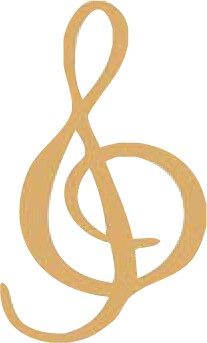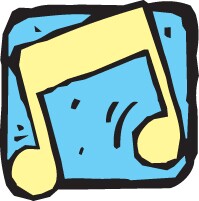A Physics Songbag
DOI: 10.1063/1.2012464
Perhaps Pythagoras was the first to meld music and science. Perhaps not. But one can easily imagine that Aristophanes, the great comic playwright, might have written a passable Pythagorean parody for any classical Greek chorus to stand and deliver. Today, many are the undergraduate and graduate students who try their hand at the time-honored enterprise of devising new lyrics to well-known melodies. Fewer are those who devise new melodies as well. And not just students take up the challenge.
On these pages, we present a mixed bag of songs that span nearly 100 years. Making the selections was difficult given the plethora of material. But whether they were written to entertain, to teach, to vent, to honor, or just to have fun, we hope you will enjoy our choices.
Music icons
Next to some of the songs that follow, you will also see large icons signaling that recordings are available on our website, http://www.physicstoday.org


hv (aitch noo)
1. All black-body radiations
All the spectrum variations
All atomic oscillations
Vary as “hv”
2. Ultraviolet vibrations
X-and gamma-ray pulsations
Ordinary light sensations
All obey “hv”
Chorus:
Here’s the right relation
Governs radiation
Here’s the new
And only true
Electrodynamical equation
Never mind your d/dt2
V times e or half mv 2
(If you watch the factor c 2)
E equals “hv”
3. Even in matters calorific
Such things as the heat specific
Yield to treatment scientific
If you use “hv”
4. In all questions energetic
Whether static or kinetic
Or electric, or magnetic
You must use “hv”
Chorus
5. There would be a mighty clearance
We should all be Planck’s adherents
Were it not that interference
Still defies “hv”
Around 1920, not so long after Max Planck proposed his eponymous constant, this song emerged at Cambridge University in the UK. The rival quantum and wave theories seemed inconsistent, yet both were necessary. As Sir William Bragg said, “We teach the wave theory on Mondays, Wednesdays, and Fridays and the quantum theory on Tuesdays, Thursdays, and Saturdays.” The author of this song is Gilbert Stead, a lecturer at the Cavendish Laboratory, who also wrote the textbook Elementary Physics in 1924 (published in updated editions for 50 years). The song was among those sung by Cavendish students and faculty after their annual dinners. The tune is “The Men of Harlech.”


How nice to be a physicist
by Arthur Roberts
How nice to be a physicist in 1947,
To hold finance in less esteem than Molotov does Haven,
To shun the importuning men with treasure who would lend it,
To think of money only when you wonder how to spend it,
Oh,
Research is long,
And time is short
Fill the shelves with new equipment,
Order it by carload shipment,
Never give
A second thought
You can have whatever can be bought.
How nice to be a physicist in this our year of grace,
To see the scornful world at last admit your rightful place,
To see the senators defer to every wise pronouncement
To fascinate the women’s club, and star at each commencement,
Oh,
Research is long,
And time is short
Drink your fill of adoration,
Glory in the new sensation,
Never give
A second thought
Sinatra holds a place that many sought.
But have you sought a physicist and place for him to dwell,
And searched the town in vain to find a vacant dungeon cell
Or tried to teach a thousand students who can’t do a sum
The girls who’d like to be Greer Garson finding radium?
Oh,
Research is long,
And time is short
Toward the thesis drive the student,
Physics was his choice imprudent,
Never give
A second thought
Brains are still a thing that can’t be bought.
Oh did you write a book on fission which you tried to sell?
Or wonder while you lectured what you could or couldn’t tell?
Or try to get declassified some nuclear equations,
Or wonder if the work you do was done at secret stations?
Oh,
Research is long,
And time is short
If you find a fact essential
Classify it confidential
Never give
A second thought
The FBI’s approval must be sought.
How nice to be a physicist in 1947,
How nice … ?
How long do you think it would take to learn something about, uh, butterflies?
Physics professor Arthur Roberts of the State University of Iowa (now the University of Iowa) was commissioned by Mariette Kuper to write “How Nice to Be a Physicist”for the MIT Radiation Laboratory reunion party held during the Washington, DC, meeting of the American Physical Society in May 1947. Robert’s songs were well known in the physics world from the late 1940s to the early 1960s. He passed away last year (see Physics Today, January 2005, page 68

This undated ditty was written by George Gamow (1904–1968), pioneer of big-bang cosmology. The protagonists, British astronomers par excellence Martin Ryle (1918–1984) and Fred Hoyle (1915–2001), were often publicly at odds over their respective visions of the cosmos. Hoyle pioneered the steady-state theory.

A liter and a gram
(Music: “A Bushel and a Peck”by Frank Loesser)
Many of Tom Lehrer’s songs, such as “The Elements” or “The Vatican Rag,” have acquired legendary status (at least for those of us of a certain age). Lehrer wrote “The Physical Revue (a music drama in one scene)” and staged it in January 1951 at Harvard University, where he was then a graduate student in mathematics. According to the program, the scene was “The last class of a mythical course, Physics 11a. (There will be a three-year intermission at the end of Scene 1.),” and these songs were included. Most if not all of the songs from there and then have never been commercially available.
I love you a liter and a gram,
A liter and a gram, and it’s crazy that I am,
A meter and a yard and a newton and a watt,
A newton and a watt, and I wanna know a lot
About you, about you
(A meter and a liter, nothing could be sweeter.)
’Cause I love you a liter and a gram,
And it’s crazy that I am for you.
I love you a poundal and a dyne,
A poundal and a dyne, and I wanna make you mine,
A foot-pound and an erg and a joule and a calorie
A joule and a calorie, and I wanna spend my salary
On you, on you
(Centigrades and Fahrenheits,
You lift me up to darin’ heights.)
’Cause I love you a poundal and a dyne,
And I wanna make you mine, I do.

The professor’s song
(Music: A. S. Sullivan — “If You Give Me Your Attention,” from Princess Ida)
If you give me your attention, I will tell you what I am.
I’m a genius and a physicist (and something of a ham).
I have tried for numerous degrees, in fact, I’ve one of each:
Of course, that makes me eminently qualified to teach.
I understand the subject matter thoroughly, it’s true,
And I can’t see why it isn’t all as obvious to you.
My lectures all are masterpieces, excellently planned,
Yet everybody tells me that I’m hard to understand,
And I can’t think why
My diagrams are models of true art, you must agree,
And my handwriting is famous for its legibility;
When I write “gravitation,” say, or any other word,
For anyone to say he cannot read it is absurd.
My demonstrations all get more remarkable every year,
Though, frankly, what they go to prove is sometimes less than clear,
And all my explanations are quite lucid, I am sure,
Yet everybody tells me that my lectures are obscure.
And I can’t think why
Consider, for example, oscillation of a spring:
The force that acts upon it is a very simple thing,
It’s kx 3, or kx 2 — no, just kx I’ll bet,
The sign in front is plus (or is it minus? … I forget)
Well, anyway, there is a force, of that there is no doubt;
All these problems are quite trivial, if you only think them out.
Yet people tell me: “I have memorized the whole term through,
Everything you’ve told us, but the problems I can’t do.”
And I can’t think why

Laura Greene, professor of physics at the University of Illinois at Urbana-Champaign, wrote this song in 2001. The melody is that of “Cheek to Cheek.” Says Greene, “Maybe the apologies should have been to Irving Berlin, who wrote the original song, but I copied the words and style from the Ella Fitzgerald / Louis Armstrong rendition, trying to follow Ella’s phrasing as much as possible. I am also a great fan of Ella in general.”

[Editors’ note: This melody was very popular in 1951, having been drawn from the hit 1946 movie The Road to Utopia, with Bing Crosby, Bob Hope, and Lauren Bacall.]
RELATIVITY
(Music: “Personality” by James van Heusen)
When Isaac Newton wrote
The laws that we all quote,
It’s now extremely apparent that he
Neglected to consider — Relativity.
What focused our attention
On the fourth dimension?
(We’d been doing so well with just three.)
’Twas Mister Einstein’s brainchild — Relativity.
And who would think
And who’d forecast
That bodies shrink
When they go fast?
It makes old Isaac’s theory
Look weary.
And so if you are near
When atom bombs appear,
And you’re reduced to a pile of debris,
You’ll know it’s largely due to — Relativity.
[Editors’ note: This melody was also well known at the time, drawn from the 1943 musical One Touch of Venus, which ran for 567 performances on Broadway with Mary Martin as Venus. In 1948, it was made into a movie with Ava Gardner.]
DON’T MAJOR IN PHYSICS
(Music: “The Trouble with Women” by Kurt Weill)
(1st student)
Oh, I once loved a sweet Physics student,
The loveliest girl one could find,
But I tried to get close and I cudent,
For she said that she wasn’t “that kind.”
More often a king weds a commoner
Than a physicist makes a housewife,
For they only are versed in phenomener
That have nothing to do with real life.
(Chorus)
So don’t ever major in Physics,
Try History, English, or Gov,
For you may learn a lot about science,
But you won’t learn a thing about love.
(2nd student)
Oh, I too loved a young Physics major,
She was pretty and healthy and pure,
But I wouldn’t take one now on a wager,
For they all are like her, I am sure.
She didn’t like couches or hammocks
Or walks in the moonlight for two.
All she thought of was thermodynammocks,
So what, tell me what, could I do?
(Chorus)
(3rd student)
Now I have the opposite status:
I like physics and my girl does not.
I tried showing her my apparatus,
But a blank smile was all that I got.
She asked me why I was in Physics,
And advised me to transfer to Ec,
And whenever I tried to talk Physics,
All she wanted to do was to neck (ugh)
(Chorus)
When you’re in k-space
(Lyrics by Dr. James D. Livingston
Tune: “Makin’ Whoopee,” by Walter Donaldson)
The bound’ries of the Brillouin zone
Just represent a law you’ve known
The satisfaction of Bragg diffraction
When you’re in k-space
Those bound’ries on the k-space maps
Are where you’ll find energy gaps
That’s one attraction of the abstraction
When you’re in k-space
And there’s the Fermi surface
Contour of energy
Things happen when that surface
Reaches the boundary
Dimensions in momentum space
Are inverse of the normal place
Just keepin’ busy can make you dizzy
When you’re in k-space
Jim Livingston had a long career as a research physicist and, since his retirement from General Electric Co, has been a senior lecturer in the department of materials science and engineering at MIT. He wrote these lyrics around 1997, as one in a series of songs for each chapter of the textbook he was teaching from. The melody hails from the 1928 Broadway musical Whoopee!

Solid state of mind
A parody of Billy Joel’s “New York State of Mind” written and performed by Lynda Williams
Some folks like astronomy and study galaxies in the local group.
Some like quantum gravity, pulling super strings from the cosmic soup.
But I’m pointing my laser, at an earthly crystalline.
I’m in a Solid State of Mind.
I’ve heard all the theories on the Higgs boson and supersymmetry.
Been around the cyclotrons and down the beam lines of high energy.
But I can build what I’m needing — I don’t need to wait for time.
I’m in a Solid State of Mind.
I really dig crystallography and the symmetries of lattices and point groups.
Is it orthorhombic, hexagonal, or face-centered cube?
X-ray diffraction is a great way to spend some time.
I’m in a Solid State of Mind.
It is so easy to get work today.
If Solid State is the physics you do.
Hard drives, cell phones, computers, hearing aids.
The Solid State — it pays.
Semiconductors have changed the way that we live today.
Junction transistors gave birth to our computer age.
Electronic switching — getting faster all the time.
I’m in a Solid State of Mind.
It is so easy to get work today.
If Solid State is the physics you do.
MOSFETS, ICs, LEDs and wafer substrates
The Solid State is here to stay.
Superconductivity at High Tc is super cool
Superfluidity of He-3 is super smooth
So many super mysteries
We’ll solve them one phase at a time.
I’m in a Solid State of Mind.
I’m building a quantum dot laser out of indium arsenide.
I’m in a Solid, or Amorphous, State of Mind.
© 2005 Lynda Williams
The World Year of Physics, which celebrates the centennial of Einstein’s miracle year of 1905, is now half over. This song was written to help celebrate the WYP by Marian McKenzie and her husband, Walter Smith, a physics professor at Haverford College in Haverford, Pennsylvania. Smith also hosts an extensive collection of physics-related songs at http://www.physicssongs.org
Lynda Williams teaches physics at Santa Rosa Junior College in Santa Rosa, California. As “The Physics Chanteuse,” she has performed at many scientific meetings and other venues for the past eight years. The composition presented here and on our website is included in her new CD collection, Parody Violation, available through http://www.scientainment.com

A lyric-writing contest
Bring out your inner muse! To help celebrate the World Year of Physics, we asked Michael Mendelson to “write an appropriate piece of music for us to publish. It will need to be sophisticated, fun, somewhat difficult, and infinitely rewarding—just like physics!” He came up with this Argentinian-style tango. Now it’s your turn to write lyrics for it. To guide you, an almost-accurate sound file is available to subscribers on our website.
Submissions must be received by 15 October 2005. They may be either e-mailed to lyrics-contest@aip.org
Mendelson got his physics bachelor’s degree in 1971 from the University of California, Berkeley, where he also enjoyed the folk-music scene. He followed that with a master’s degree in comparative folklore and mythology from UCLA, then a long and continuing career working with computer systems and networks. All along the way, he has composed and played music.

We are grateful to several individuals for their help. Walter Smith, whose website (
